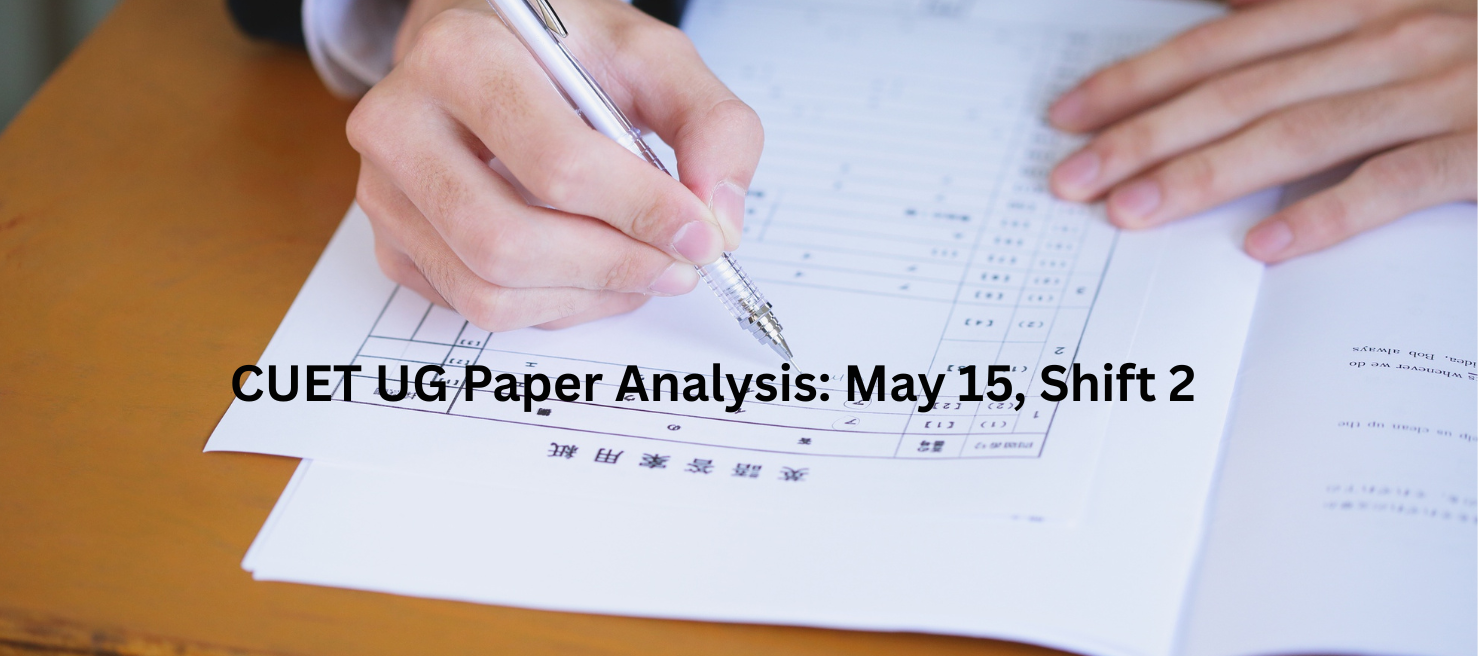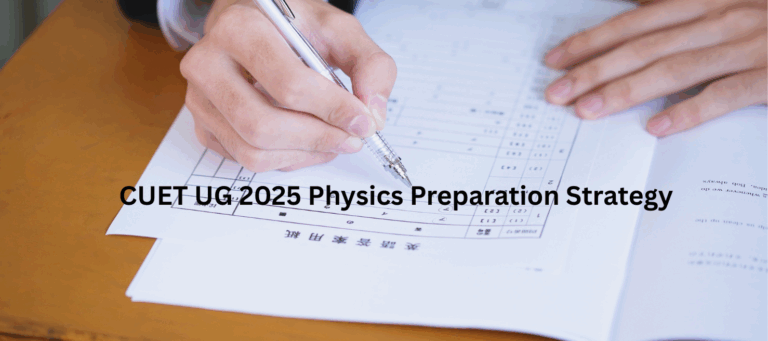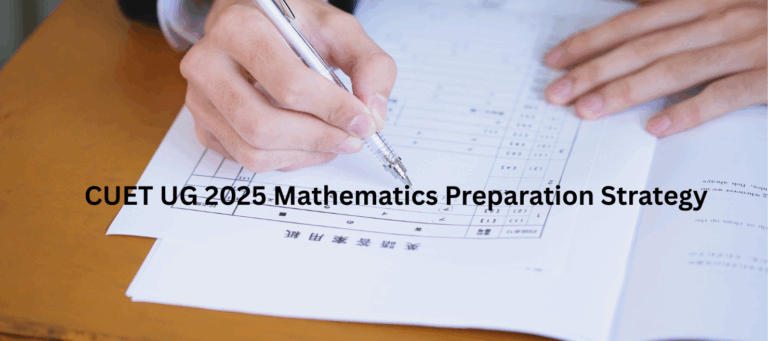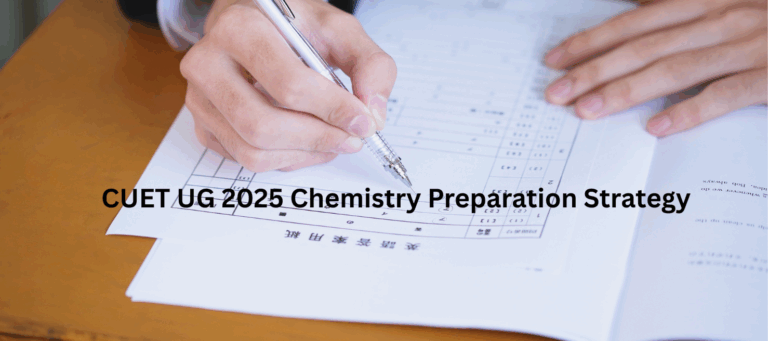
The CUET exam date 2025 for the second shift on May 15 was conducted from 3 PM to 6 PM. Candidates appeared for the subjects of History, Accountancy, Biology, Political Science, and Business Studies. The overall difficulty level of the second shift exam on the third day was moderate, although some students found it harder than previous shifts. Specifically, the General Aptitude Test (GAT) and Business Studies were considered more difficult, while the students perceived the Political Science subject as easier.
Check out our blogs for a detailed CUET UG 2025 Paper Analysis, including subject-wise difficulty levels, question types, and student feedback!
- May 13th CUET UG Paper Analysis Shift 1
- May 13th CUET UG Paper Analysis Shift 2
- May 14th CUET UG Paper Analysis Shift 1
- May 14th CUET UG Paper Analysis Shift 2
- May 15th CUET UG Paper Analysis Shift 1
- May 16th CUET UG Paper Analysis Shift 1
- May 16th CUET UG Paper Analysis Shift 2
- May 19th CUET UG Paper Analysis Shift 1
- May 19th CUET UG Paper Analysis Shift 2
- May 20th CUET UG Paper Analysis Shift 1
- May 20th CUET UG Paper Analysis Shift 2
- May 21st CUET UG Paper Analysis Shift 1
- May 21st CUET UG Paper Analysis Shift 2
- May 22nd CUET UG Paper Analysis Shift 1
- May 22nd CUET UG Paper Analysis Shift 2
- May 23rd CUET UG Paper Analysis Shift 1
- May 23rd CUET UG Paper Analysis Shift 2
- May 24th CUET UG Paper Analysis Shift 1
- May 24th CUET UG Paper Analysis Shift 2
- May 26th CUET UG Paper Analysis Shift 1
- May 26th CUET UG Paper Analysis Shift 2
- May 27th CUET UG Paper Analysis Shift 1
- May 27th CUET UG Paper Analysis Shift 2
- May 28th CUET UG Paper Analysis Shift 1
- May 28th CUET UG Paper Analysis Shift 2
- May 29th CUET UG Paper Analysis Shift 1
- May 29th CUET UG Paper Analysis Shift 2
- May 30th CUET UG Paper Analysis Shift 1
- May 30th CUET UG Paper Analysis Shift 2
- May 31st CUET UG Paper Analysis Shift 1
- June 2nd CUET UG Paper Analysis Shift 1
- June 2nd CUET UG Paper Analysis Shift 2
- June 3rd CUET UG Paper Analysis Shift 1
- June 3rd CUET UG Paper Analysis Shift 2
CUET UG 2025 Exam Overview
Below is the exam overview of CUET UG 2025.
| Exam Particulars | Exam Details |
| Total Subjects Offered | 37 (13 Languages + 23 Domain Subjects + 1 General Aptitude Test) |
| Medium | 13 Indian languages (Assamese, Bengali, English, Gujarati, Hindi, Kannada, Malayalam, Marathi, Punjabi, Odia, Tamil, Telugu, and Urdu) |
| Subjects to Choose | Up to 5 subjects |
| Total Marks of CUET Exam | 250 |
| Questions per Subject | 50 Compulsory Questions |
| Marking Scheme | +5 for correct answer, -1 for incorrect answer, and no marks for unattempted questions |
| Exam Mode | CBT Mode |
| Duration | 60 minutes per subject |
Where To Check CUET UG 2025 Exam Analysis
CollegeDost has put together a helpful and comprehensive analysis of the CUET UG 2025 exam for each shift. You can find a clear breakdown of each subject along with feedback from students. We’ve covered all previous shifts starting from May 13th, and you can find all of them in the link below. Our insights are primarily based on students who took the exams, based on their feedback, and our experts analyse the entire memory-based paper to provide their review of the exam. This will give you a good idea of what to expect and how to prepare!
If you haven’t taken the CUET UG exam yet, visit CollegeDost to access our analysis and prepare effectively for your upcoming tests
👉 Check CUET UG 2025 Exam Analysis on CollegeDost
CUET UG 2025 Exam: Shift Timings Today
Check the CUET UG 2025 exam shift timings in the table below.
| CUET UG 2025 Slot Time for 15th May | Reporting Time | Gate Closing Time | Shift Timing |
| CUET 2025 Shift 1 | 7 AM | 8.30 AM | 9 AM to 12 PM |
| CUET 2025 Shift 2 | 1 PM | 2.30 PM | 3 PM to 6 PM |
CUET UG 2025 Exam Analysis: Based on Number of Attempts
Candidates can check the number of good attempts that they can expect in the exam from the following table.
| Subjects | Good Attempts | Difficulty Level | Key Topics |
| English | 45–48 | Moderate | Vocabulary-focused; more passages than usual; match the following included. |
| General Aptitude Test (GAT) | 50–55 | Moderate to Difficult | A few tricky questions from Quantitative Aptitude (QA) were difficult and time-consuming |
| Business Studies | 40–45 | Moderate to Difficult | Slightly tougher than other shifts, case studies, and assertion-reasoning. |
| Accountancy | 42–46 | Moderate | Computerised Accounting included; a few tricky language-based questions. |
| History | 40–44 | Moderate | Statement-based, chronology, committees, and terminology questions. |
| Political Science | 43–47 | Easy to Moderate | Conceptual MCQS; good NCERT coverage; no out-of-syllabus questions. |
| Biology | 41–46 | Moderate | NCERT-based, diagram-based, and direct concept questions. |
CUET UG 2025 Exam Analysis: May 15 2025, Shift 2
The CUET exam date 2025 was conducted on May 15th, shift 2, for the General Aptitude Test, English, History, Accountancy, Biology, Political Science, and Business Studies. As per the initial reaction of the students, the exam for the Shift 2 is considered Moderate. Check out the subject-specific analysis and weightage of each chapter.
CUET UG 2025 GAT Paper Analysis
It was reported that Quantitative Aptitude (QA) was difficult and time-consuming in this shift, with a big emphasis on direct formula-based questions from the Mensuration chapter. General Knowledge (GK) included questions from various topics, such as books/authors, vitamins/proteins, and awards. Overall, the difficulty of the paper was moderate to tough and required students’ accuracy and management of time.
| Particulars | Details |
| Quantitative Aptitude (QA) | Tough and time-consuming; direct formula-based questions from Mensuration. |
| General Knowledge (GK) | Questions from books and authors, vitamins and proteins, and awards. |
| Overall Difficulty | Moderate to tough. |
General Awareness-Chapterwise Weightage
| Category | Expected Questions |
| Geography | 7 |
| Science | 4 |
| Personalities | 4 |
| Polity | 3 |
| Defence | 2 |
| Awards | 2 |
| Sports | 1 |
| Currency | 1 |
| Miscellaneous | 1 |
Logical reasoning-Chapterwise Weightage
| Topic | Expected Questions |
| Visual Reasoning | 4 |
| Series | 2 |
| Coding-Decoding | 2 |
| Arrangement | 2 |
| Clocks | 2 |
| Analogy | 1 |
| Family Tree | 1 |
| Calendar | 1 |
| Data Sufficiency | 1 |
| Directions | 1 |
| Statement-Conclusion | 1 |
Numerical Ability-Chapterwise Weightage
| Topic | Expected Questions |
| Time and Work | 2 |
| Ratio | 2 |
| Simplification | 1 |
| Fractions | 1 |
| HCF-LCM | 1 |
| Problems on Age | 1 |
| Percentage | 1 |
| Profit, Loss & Discount | 1 |
| Simple Interest | 1 |
| Area | 1 |
| Volume | 1 |
| Speed, Time, Distance | 1 |
| Mean & Mode | 1 |
| Triangle | 1 |
| Trigonometry | 1 |
CUET UG 2025 Business Studies Paper Analysis
The Business Studies paper in this shift was slightly harder than in other shifts. There were two case studies – one from Marketing Management (Marketing Mix) and one from Principles of Management, both with 5 questions. There were also 2-3 questions framed in Assertion-Reasoning and Match the Following formats (which added to the exam complexity).
| Particulars | Details |
| Difficulty Level | Slightly tougher than other shifts’ Business Studies (B.ST) papers. |
| Case Study 1 | From Marketing Management (Marketing Mix) – 5 questions. |
| Case Study 2 | From Principles of Management – 5 questions; direct in other shifts. |
| Syllabus Coverage | Questions appeared from almost all chapters in the syllabus, with more emphasis on Marketing Management and Principles of Management chapters. |
| Special Question Types | 2–3 questions from Assertion-Reasoning and Match the Following. |
CUET Business Studies Chapterwise Weightage
| Topics | Number of Questions |
| Nature and Significance of Management | 5-6 |
| Principles of Management | 2-3 |
| Business Environment | 3-4 |
| Planning | 2 |
| Organizing | 5 |
| Staffing | 6 |
| Directing | 4-5 |
| Controlling | 4-5 |
| Marketing | 5-6 (including case studies) |
| Consumer Protection | 2 |
| Entrepreneurship Development | 2 |
CUET UG 2025 Accountancy Paper Analysis
In this shift, the questions were taken mostly from the syllabus, but many of them were in different language patterns. Most questions of the Accountancy paper were relatively straightforward. There were also 3 questions directly from the topic of Computerised Accounting, which suggests the subject carries a lot of weight in the paper.
| Particulars | Details |
| Question Source | From the syllabus, but with different language patterns. |
| Question Nature | Some questions were tricky and confusing. |
| Computerised Accounting | 3 questions were asked about this topic. |
CUET Accountancy Chapterwise Weightage
| Topics | Number of Questions |
| Reconstitution of Partnership | 10–12 |
| Analysis of Financial Statements | 7–8 |
| Accounting for Share and Debenture Capital | 6–7 |
| Accounting – Not for Profit | 5–6 |
| Computerized Accounting System | 4–5 |
CUET UG 2025 English Paper Analysis
In this shift of the English paper, there were 4 passages with 4 questions each, more than in other shifts. The passages were easy to attempt. There were roughly 6–8 sentence rearrangement questions, adding complexity to language understanding. There was a substantial focus on vocabulary. Phrasal verbs were asked in a Match the Following format.
| Particulars | Details |
| Passage-Based Questions | No fixed pattern or number; this shift had 4 passages with 4 questions each. |
| Passage Difficulty | Easy to attempt, but more in number compared to other shifts. |
| Sentence Rearrangement | 6–8 questions were asked. |
| Vocabulary Focus | The paper was vocabulary-focused; preparation helped in attempting questions. |
| Phrasal Verbs | Asked in the Match the Following format. |
CUET English Chapterwise Weightage
| Topics | Number of Questions |
| Comprehension | 15 |
| Parts of speech | 3–4 |
| Para jumbles | 3–4 |
| Synonyms and antonyms | 2–3 |
| Active/passive voice | 3–4 |
| Fill in the blanks | 3–4 |
| Incorrect/correct statement | 3–4 |
| Phrases and meaning | 5–6 |
CUET UG 2025 Political Science Paper Analysis
The Political Science paper featured five cartoon-based questions that were worth a combined total of 25 marks, thereby providing a more visual and interpretative assessment. The overall attempt rate was high, and, for the most part, most students were able to attempt all 50 questions. Only 2-3 questions were reported to be tricky and confusing. The questions came from various places in the NCERT materials.
| Particulars | Details |
| Cartoon-Based Questions | 5 questions, worth a total of 25 marks. |
| Attempt Rate | Most students could attempt all 50 questions. |
| Tricky Questions | Only 2–3 questions were tricky and confusing. |
| Source of Questions | Questions were asked from the NCERT boxes, maps, etc. |
CUET Political Science Chapterwise Weightage
| Chapters | Number of Questions |
| Recent Developments in Indian Politics | 8–9 |
| Challenges to the Congress System | 5 |
| Cold War Era | 3–4 |
| The End of Bipolarity | 2–3 |
| US Hegemony in World Politics | 2–3 |
| Alternative Centers of Power | 2–3 |
| Contemporary South Asia | 3–4 |
| International Organizations | 2–3 |
| Security in the Contemporary World | 2–3 |
| Globalization & Environment and Natural Resources | 6–7 |
CUET UG 2025 History Paper Analysis
The majority of students did not attempt all 50 questions due to the confusion and time-consuming manner in which the paper was organized. However, students with proper mastery of the NCERT textbooks will have easily tackled almost 48 questions. The exam included a blend of statement-based questions and questions referring to committees.
| Particulars | Details |
| Attempt Rate | Most students could not attempt all 50 questions due to confusion and time constraints. |
| Ease of Questions | Around 48 questions were easy for those with a strong grasp of the NCERT textbooks. |
| Question Types | Included statement-based questions. |
| Committees & Leadership | Questions on various committees, their chairpersons, and the Constituent Assembly. |
| Chronology-Based Questions | Related to the Revolt of 1857, Mahatma Gandhi, and Colonialism. |
| Direct Terminology Questions | Questions on historical terms like Amla, Amil, Guzar, etc. |
CUET History Chapterwise Weightage
| Unit/Chapter | Approximate Number of Questions |
| Case Studies (2 total, 5 questions each) | 10 (5 in each) |
| An Imperial Capital: Vijayanagara | 3–4 |
| Kings and Chronicles | 3–4 |
| The Mughal Courts | 3–4 |
| Framing the Constitution | 2–3 |
| Thinkers, Beliefs, and Buildings | 2–3 |
| Bhakti-Sufi Traditions | 2–3 |
CUET UG 2025 Biology Paper Analysis
The Biology module in this session was wide-ranging, featuring a good balance of conceptual and application questions. Questions included fruit development without fertilization and calculations about fertilization rate under Reproduction and Fertilisation. There was a situational question about cuckoo’s brood parasitism. The paper included technical questions on human reproduction, which included a question on the sperm’s pathway and a sequential question. There were a total of 5 Match the Columns questions covering enzyme, hormones, reproductive organs, diseases, and ecological vocabulary. It also had two comprehension passages for a total of 7 questions between them.
| Particluars | Details |
| Reproduction and Fertilization | Questions on fruit formation without fertilization; calculations related to fertilization rates. |
| Genetics | 2–3 questions on Mendelian inheritance and gene disorders. |
| Genetic Disorders | 2 questions on common human genetic diseases and their inheritance patterns. |
| Species-Area Curve | Question on biodiversity and species-area relationship in ecology. |
| Cuckoo’s Parasitism | Situational question on brood parasitism involving the cuckoo and the crow. |
| Human Reproduction | Detailed questions on sperm pathway and hormonal sequence during menstruation (FSH, LH, Estrogen, Progesterone). |
| Enzyme Functions | Questions on various enzymes, including one specifically on DNA ligase. |
| Contraceptive Methods | Practical application questions on IUCDs and female contraceptives. |
| Match the Columns | 5 questions covering enzymes, hormones, reproductive organs, diseases, and ecological terms. |
| Comprehension Passages | Two passages: one on biodiversity conservation and another on diseases and medicines. |
CUET Biology Chapterwise Weightage
| Topics | Number of Questions |
| Applications of Biotechnology | 4 |
| Biodiversity and Its Conservation | 5 |
| Biotechnology: Principles and Processes | 4 |
| Ecosystem | 4 |
| Evolution | 4 |
| Human Health and Diseases | 4 |
| Human Reproduction | 3 |
| Microbes in Human Welfare | 3 |
| Molecular Basis of Inheritance | 5 |
| Organisms and Populations | 3 |
| Principles of Inheritance and Variation | 3 |
| Reproductive Health | 5 |
| Sexual Reproduction in Flowering Plants | 3 |
| Total | 50 |
CUET Exam Syllabus 2025
Check the CUET exam syllabus and types of probable questions given below in the table.
| CUET exam syllabus | Question Types |
| Language Subjects: Language to be tested through Reading Comprehension (based on different types of passages–Factual, Literary, and Narrative), Literary Aptitude, and Vocabulary | Language skills will be assessed through reading comprehension based on various types of passages such as factual, literary, and narrative, along with evaluation of literary aptitude and vocabulary. |
| Domain Subjects: As per the NCERT syllabus | MCQS Based on Class 12 Syllabus |
| General Aptitude Test: General Knowledge, Current Affairs, General Mental Ability, Numerical Ability, Quantitative Reasoning (Simple application of basic mathematical concepts, arithmetic/algebra, geometry/mensuration/statistics), Logical and Analytical Reasoning | The section will assess General Knowledge, Current Affairs, General Mental Ability, Numerical Ability, Quantitative Reasoning (based on simple applications of basic mathematical concepts from arithmetic, algebra, geometry, and mensuration taught up to Grade 8), as well as Logical and Analytical Reasoning. |
Student Reviews For CUET UG 2025 May 15th Shift 2 Exam
Most students from different states found CUET UG 2025 Shift 2, which was held on May 15th, to be easy to moderate compared to the previous shift. Here is a summary of what students perceived about the exam.
English
Difficulty Level: Moderate
Feedback: According to the students, the English paper was of moderate difficulty, had more vocabulary questions, synonyms, antonyms, and rearrangement. Straightforward passages were easy for many, while others were not able to manage the increased number of passages compared to the other shifts. Generally, weaker students with vocabulary performed fairly well.
General Aptitude Test (GAT)
Difficulty Level: Moderate to Difficult
Feedback: The General Test was considered to be of moderate difficulty, also included a little mix of logical reasoning, quantitative aptitude, and general knowledge. Some students felt that the reasoning and quantitative parts were quite lengthy, while the general knowledge questions were mainly based on NCERT materials. Lastly, students needed to manage the time because of the variety of questions.
Business Studies
Difficulty Level: Difficult
Feedback: The Business Studies paper was slightly tougher than other shifts, including two case studies. First, a marketing case from Marketing Management (Marketing Mix) and Principles of Management. The Principles of Management case was direct in other shifts, but more challenging for this shift. No questions came from deleted chapters of the syllabus, and overall, broad coverage within the syllabus. Also, the paper had 2-3 questions designed in the Assertion-Reasoning format or the Match the following format.
Accountancy
Difficulty Level: Moderate
Feedback: The accountancy paper had 3 questions on Computerised Accounting. In general, most questions were fairly easy, but some were tricky and quite confusing, requiring careful consideration.
History
Difficulty Level: History
Feedback: The History section included several statement questions from the Constituent Assembly, and questions were asked about the chronology of events, covering key events such as the Revolt of 1857, the role of Mahatma Gandhi, and Colonialism. Some direct terminology questions were also asked, involving historical terms like Amla, Amil, and Guzar, testing students’ factual recall.
Political Science
Difficulty Level: Moderate
Feedback: The Political Science paper was moderate, and the source for the paper was only the NCERT textbooks. There were both statement questions, passage questions, and some questions based on cartoons that required thinking. The paper contained a larger number of statement-based questions that required a level of understanding of the concepts from the students.
Biology
Difficulty Level: Moderate
Feedback: The Biology paper proved to be of a moderate level of difficulty for most students, as it required applicants to know and understand key ideas and major concepts, not memorize them. Many students found the questions were from the NCERT books, making it easy for those students to prepare. Students appreciated that the paper had practical or scenario-based questions and used diagrams.
Overall Feedback
Although the exam was perceived as moderate to tough overall, students who prepared well and studied the NCERT and were good time managers could handle the paper at a manageable level. The number of passage-based questions was greater, and there were also several formats of questions, making it harder. Good preparation and time management were needed to consider how to sit the exam.
CUET UG 2025 Exam Day Guidelines
Given below are a few CUET UG 2025 exam day guidelines that students need to follow.
- Carry Only Required Items: Only take your printed admit card (with passport-size photograph), your valid photo ID (Aadhaar or PAN card), a transparent ballpoint pen, and a transparent water bottle. Candidates can check all the CUET exam details on the admit card and are advised to adhere to the instructions.
- Be On Time: Report to the exam center well in advance relative to your reporting time (7:00 AM for Shift 1 and 1:00 PM for Shift 2). If you are late, you will not be allowed to enter.
- Dress Code: You should wear light clothes without large buttons or badges. You may wear slippers or sandals only – no shoes or high heels.
- Prohibited Items: Do not bring mobile phones, smart watches, electronic devices, bags, books, or food if not medically required (with documentation).
- Maintain Discipline: Be seated in your assigned seat, only do rough work on the sheets provided, and do not perform any unfair practice or make any noise in the exam hall.
CUET Dress Code For Females
| Category | Allowed | Not Allowed |
| Clothing | Half-sleeved, simple kurtis/tops | Full-sleeved, heavily embroidered, or layered clothing |
| Bottom Wear | Simple leggings, trousers, salwar | Skirts, jeans with extra pockets |
| Footwear | Slippers, flat sandals | Heels, closed-toe shoes, boots |
| Accessories | None | Jewelry (earrings, rings, bangles, bracelets, belts) |
| Electronic Items | None | Smartwatches, Bluetooth devices, and wired accessories |
CUET Dress Code 2025 for Males
| Category | Allowed | Not Allowed |
| Clothing | Half-sleeved, plain shirts or t-shirts | Full-sleeved shirts, layered clothing, and embroidery |
| Bottom Wear | Light trousers, simple jeans | Cargo pants, jeans with too many pockets |
| Footwear | Slippers, sandals | Shoes, sneakers, boots |
| Accessories | None | Watches, belts, caps, sunglasses, metallic items |
| Electronic Items | None | Smartwatches, Bluetooth devices, and wired accessories |
Things Allowed Inside the Examination Hall
- Transparent Water Bottle
- Admit Card (printed copy)
- Face Mask & Gloves (if applicable)
- Personal Hand Sanitiser (50 ml)
- Rough Sheets (provided by the exam centre)
- Passport-size Photograph (same as uploaded in the application)
- Simple Black/Blue Ballpoint Pen (if specified)
- Valid Photo ID Proof (Aadhar, PAN, Passport, etc.)
Things Not Allowed Inside the Examination Hall
- Books, Notes, or Any Study Material
- Mobile Phones & Smartwatches
- Wallets, Handbags, Sunglasses
- Bags, Pouches, or Any Items with Metal Components
- Electronic Gadgets (earphones, calculators, etc.)
- Jewellery, Caps, or Hats
- Food or Drinks (except water)
- Any Written or Printed Papers
What’s New In CUET UG 2025?
Check out some new changes introduced by UGC and which will be implemented from CUET UG 2025 onwards.
- Students can now take CUET UG exams in any subject, regardless of their Class 12th subjects.
- CUET UG will be conducted solely in CBT mode.
- CUET subjects have been reduced to 37 from 63. Teaching Aptitude, Entrepreneurship, and Legal Studies subjects have been removed.
- The duration of the test is 60 minutes for all the subjects.
- The GAT scores will decide the admission for the removed CUET subjects.
- There will be no optional questions.
Frequently Asked Questions
1. What were the major difficulties students faced regarding History in CUET UG 2025?
Students found chronology-based questions and terminology-related questions on historical terms like Amla and Amil to be challenging, along with statement-based questions about committees and the Constituent Assembly.
2. How important was the vocabulary preparation for the English section in CUET UG 2025?
The 2nd shift’s English paper was vocabulary-dependent; it focused on phrasal verbs, synonyms, antonyms, and sentence rearrangement.
3. Were there any surprises in the question pattern for CUET UG 2025, 15th May, 2nd shift?
Yes, the number of passage-based questions in English was higher than usual, and the Business Studies section included two detailed case studies, unlike other shifts where one was more direct.
4. Which topics in Biology were emphasized in CUET UG 2025, 15th May, 2nd shift?
Topics such as reproduction without fertilization, Mendelian genetics, the species-area curve in ecology, and contraceptive methods were prominently featured, alongside practical and comprehension-based questions. There was a situational question about cuckoo’s brood parasitism. The paper included technical questions on human reproduction, which included a question on the sperm’s pathway and a sequential question.
5. Did the CUET UG 2025 exam include questions from deleted chapters in any subject?
No, there were no questions from deleted chapters across all subjects in this shift, adhering strictly to the revised syllabus.
6. What is the CUET exam pattern for each subject?
Each subject paper of the CUET UG exam pattern consisted of 50 compulsory questions. Students need to complete each paper within 60 minutes.






